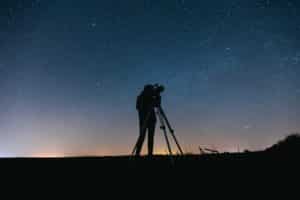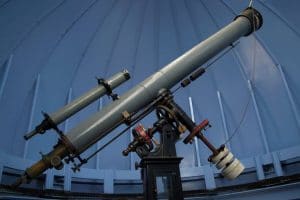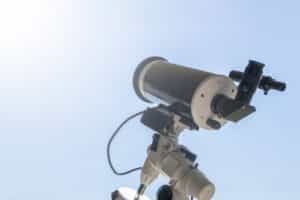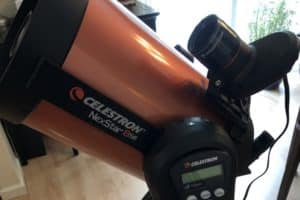On a budget and looking for the best telescope under $200? You don’t need to spend a fortune, as long as you know your priorities and are willing to make some trade-offs. In this post, we’ll share with you our top 7 recommendations for this price category.
See also:
(Before we begin, please note that product pricing, price categories and availability are accurate as of the date of this post, but are subject to change. This post represents the author’s opinion, based on research and experience, of the “best” or “top” telescopes in this category; the opinions of others may vary.)
Best Telescope Under $200 (Our Top 7 Picks)
Celestron Astromaster 70AZ Refractor Telescope
Budget refractor telescope for beginners. The Astromaster 70AZ from Celestron is a ready-for-anything refractor telescope. Even if you’ve never used a telescope before, you’ll be navigating the nighttime sky in minutes with this telescope. It comes with all the accessories you need to get started, including two eyepieces (10mm and 20mm), a travel tripod (steel, full-height adjustable), an image star diagonal, and a red dot finder scope.
Scorecard – Celestron Astromaster 70AZ
| Category | Our Verdict | Why? |
|---|---|---|
| Skill Level | Beginner | Easy to get started |
| Quality | 4 out of 5 | Great component quality |
| Ease of Use | 4 out of 5 | Setup in minutes |
| Power & Clarity | 3 out of 5 | Average |
| Control | 3 out of 5 | Average, AZ mount |
| Portability | 4 out of 5 | Light-weight and easy to move |
| Accessories | 3 out of 5 | Everything needed plus two eyepieces |
| Overall Value | 4 out of 5 | Great value |
Why We Like It
With an aperture of 70mm and magnification of 45x to 90x, it’s not the highest-powered telescope in this price range. However, it’s super easy and fast to setup and use, and it doesn’t require collimation, which makes it great for beginners. At this magnification level, you’ll be able to get bright and clear images of objects like Jupiter, Orion Nebula, the Moon, Mars, and Saturn. Or, you can use it for viewing objects and landscapes in the daytime.
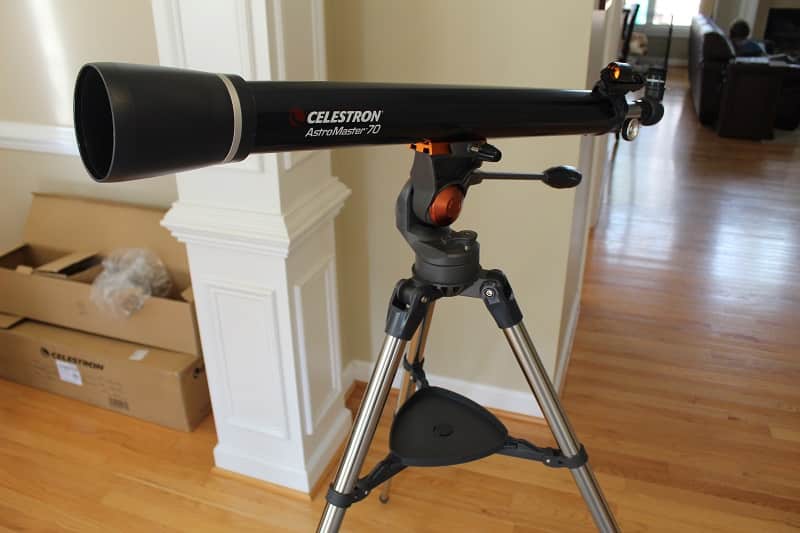
Image Credit: Brian Taylor / TelescopeGuide.org
Additionally, the Astromaster 70AZ telescope comes with durable, professional, high-quality components and materials. It’s engineered with fully-coated all-glass optics, a lightweight frame, and a manual Alt-Azimuth mount. Finally – and for many people, this is important – it weighs just 11 lbs. which makes it ultra-portable and easy to take with you on the go.
Pros
- A great telescope for beginners
- Everything you need to get started
- Super lightweight and portable, weighing just 11 lbs.
- Budget-friendly
- Easy to control & use
Cons
- The tripod is not the best – Some users have reported stability problems
- Lower magnification and smaller aperture for light collection
Recommended Accessories
Click here to expand- Smartphone adapter:
Orion Observer 70mm II AZ Refractor
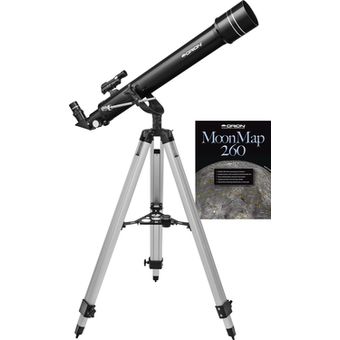
Image Credit: Orion (Used with Permission)
One of our favorite budget refractor telescopes at a super-affordable price point. The Orion Observer 70mm II is, in our view, one of the best telescopes under $200 and one of our top picks in this category for a few reasons.
First, refractors, with their straightforward design, will provide some of the brightest images at this price point. The Orion Observer 70mm II stands out here. It provides very crisp, sharp images for the price. You will get a great view of the moon and be able to see the rings of Saturn and details of Jupiter as well as some of the Messier objects with the right sky conditions.
Second, this telescope has a quality build and nice finish. Orion has done a good job putting together a solid product for the price. Third, while not the lightest telescope in the group, it’s definitely portable and can be used in a variety of locations.
Scorecard – Orion Observer 70mm II AZ Refractor
| Category | Our Verdict | Why? |
|---|---|---|
| Skill Level | Beginner | Easy to get started |
| Quality | 4 out of 5 | Good quality build and design for price |
| Ease of Use | 4 out of 5 | Simple, fast, and easy to use |
| Power & Clarity | 3 out of 5 | Not a high-powered, but good for price point |
| Control | 3 out of 5 | Average, AZ mount |
| Portability | 4 out of 5 | Lightweight and portable |
| Accessories | 4 out of 5 | Comes with lenses, tripod and Moon Map |
| Overall Value | 4 out of 5 | Top value |
Why We Like It
As mentioned above, this telescope provides very good images for its price category. For a starter telescope, you will be getting very good value and be able to see all you need to determine whether astronomy really interests you and whether you want to invest in a larger scope. The Orion Observer 70mm II comes with a multi-coated, achromatic, 70mm glass objective lens, with a focal length of 700mm (f/10). This kind of glass lens will take in 36% more light than a 60mm lens, resulting in brighter, crisper views. The lens quality / coating also results in less chromatic distortion than some other refractor telescopes, particularly when viewing the Moon.
The Orion Observer 70mm II comes with a great set of starter accessories as well. These two 1.25″ Kellner eyepieces (25mm and 10mm), an altazimuth telescope mount, a red-dot sight, a 1.25″ rack and pinion focuser, a 90-degree star diagonal, and the Orion Moon Map, which will help you understand and identify features of the Moon.
In conclusion, this is an excellent telescope that, in our view, provides top value at a low price point.
Pros
- Sharp, crisp images with multi-coated, achromatic lens
- Light and easily portable at just 7.4 lbs.
- Good set of accessories, including tripod, lenses and Orion Moon Map
Cons
- Not for high-powered viewing
Orion SkyScanner 100mm Tabletop Reflector Telescope
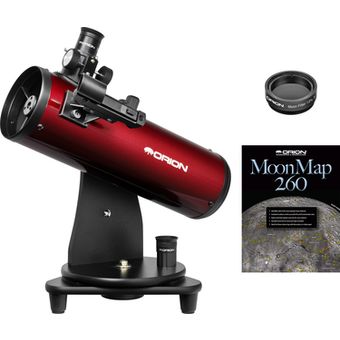
Image Credit: Orion (Used with Permission)
For the perfect blend of ease-of-use, affordability, portability, and optical quality – the Orion SkyScanner 100mm is an excellent option. It’s a classic Newtonian reflector (with a parabolic vs. spherical mirror) and features a super user-friendly tabletop dobsonian mount. And the optical quality here is better than most entry-level reflectors.
Celestron – 80mm Travel Scope – Portable Refractor Telescope
Fantastic travel scope with wide 80mm aperture. This is basically the same as the Celestron 70mm Travel Scope (one of the more popular telescopes from Celestron), but we like the 80mm for just a little more brightness and power.
Scorecard – Celestron 80mm Travel Scope
| Category | Our Verdict | Why? |
|---|---|---|
| Skill Level | Beginner | Easy to get started |
| Quality | 3 out of 5 | Designed to be as light and inexpensive as possible |
| Ease of Use | 4 out of 5 | Simple, fast, and easy to use |
| Power & Clarity | 2 out of 5 | Not a high-powered telescope |
| Control | 3 out of 5 | Average, AZ mount |
| Portability | 5 out of 5 | Ultra-lightweight and highly portable |
| Accessories | 4 out of 5 | Love the travel backpack, plus comes with smartphone mount |
| Overall Value | 4 out of 5 | Great value |
Why We Like It
For obvious reasons, the #1 reason to buy this 80mm travel telescope from Celestron is for portability. It’s marketed as a travel telescope “for terrestrial and celestial viewing on the go”. It weighs just 3.3 lbs. (that’s not a typo!) and it can be setup and ready to go in seconds.
It comes with all the accessories you need, including two eyepieces (20mm and 10mm), an erect image star diagonal, a finder scope, smartphone adapter, tripod, and a custom backpack for traveling. With 80mm aperture it’s a little better in terms of image brightness/clarity compared to its sibling 70mm travel scope. For some reason this one is not as popular as the 70mm version. However, we like this one for the extra 10mm (plus the smartphone mount that comes with the 80mm but not the 70mm).
In terms of control and power, don’t expect this telescope to perform like its heavier non-traveling peers. The magnification is 20x to 40x with the included eyepieces. Importantly, the optics are still glass and fully-coated. The Alt-Azimuth mount is serviceable. Overall, it’s a great option for travelers if portability is your top priority.
Pros
- Perfect for traveling, includes travel backpack
- Comes with smartphone mount
- Ultra-lightweight and highly portable
- Everything you need to get started, including eyepieces, height-adjustable tripod, finder scope, and software
Cons
- Lower-powered compared to non-traveling telescopes
Gosky 2019 Updated 20-60×80 Angled Telescope
Our pick for best spotting telescope under $200 for daytime, landscape, and wildlife. If you’re looking for a telescope primarily for terrestrial viewing, this Gosky angled spotting telescope (updated in 2019) is an excellent value. It delivers a 1-2-3 punch with its enhanced optical performance, rugged durability, and ultra-portability – making it the ideal companion for a variety of outdoor activities, sports, wildlife observation, shooting and hunting. Plus, at nighttime you can still get a spectacular view of the moon and other astronomical sights.
Scorecard – Gosky 2019 Updated 20-60×80 Angled Telescope
| Category | Our Verdict | Why? |
|---|---|---|
| Skill Level | Beginner | Easy to get started |
| Quality | 4 out of 5 | Great component quality, water-proof and fog-proof design |
| Ease of Use | 4 out of 5 | Easy to zoom in on target |
| Power & Clarity | 3 out of 5 | Fine for spotting telescope |
| Control | 3 out of 5 | Just a basic tripod mount |
| Portability | 5 out of 5 | Yes! |
| Accessories | 4 out of 5 | Everything needed plus smartphone adapter |
| Overall Value | 4 out of 5 | Great value |
Why We Like It
First, the optical performance on this telescope is outstanding. It features a 80mm green film objective lens, variable 20x to 60x zoom with a dynamic lens focusing system, plus a multi-coated green film eyepiece lens.
Second, this telescope is ultra-durable, with rubber armor and a water-proof, fog-proof design. Plus, it comes with all the essential accessories including a carrying case, eyepiece and lens protection covers, tabletop full-metal tripod, cleaning cloth, and even a digiscoping smartphone mount so you can easily take photos and videos with the scope.
And finally, it’s small, light, and designed for the outdoor enthusiast. However, do keep in mind this telescope is designed for daytime viewing first and foremost. (While you can certainly get some great nighttime views, the angle of the telescope can make things tricky when trying to look directly up.)
Pros
- Great optical performance
- Well-built and high quality components for durability
- Lightweight and easy to take with you anywhere
Cons
- Don’t get this telescope if you’re primarily interested in astronomical viewing
- The tripod is tabletop vs. full-height
Gskyer 70mm AZ Mount Refractor Telescope for Kids
Excellent telescope under $200 for kids. (Or… for beginners who are kids at heart!) This Gskyer 70mm makes the perfect holiday or birthday present for someone who is interested in getting started with astronomy.
Scorecard – Gskyer 70mm AZ Mount
| Category | Our Verdict | Why? |
|---|---|---|
| Skill Level | Kids and Beginners | Aimed at people just getting started |
| Quality | 3 out of 5 | Designed to be as light and inexpensive as possible |
| Ease of Use | 4 out of 5 | It doesn't get any simpler to use, as long as you're not looking straight up |
| Power & Clarity | 2 out of 5 | Not a high-powered telescope |
| Control | 3 out of 5 | Simple AZ mount / tripod |
| Portability | 5 out of 5 | Ultra-lightweight and highly portable |
| Accessories | 3 out of 5 | Comes with a carrying case and a smartphone mount |
| Overall Value | 4 out of 5 | Great value |
Why We Like It
First and foremost, this is an incredibly popular telescope – and that’s because it offers everything you need to get started with a decent-quality telescope at a super affordable price. The magnification (16x to 40x with the included 25mm and 10mm eyepieces) is fine for beginners. (Additionally, it includes a 3x Barlow lens.) You’ll be able to get good views of the moon, solar system objects, and star clusters. Also, it can be used for daytime viewing and wildlife observation.
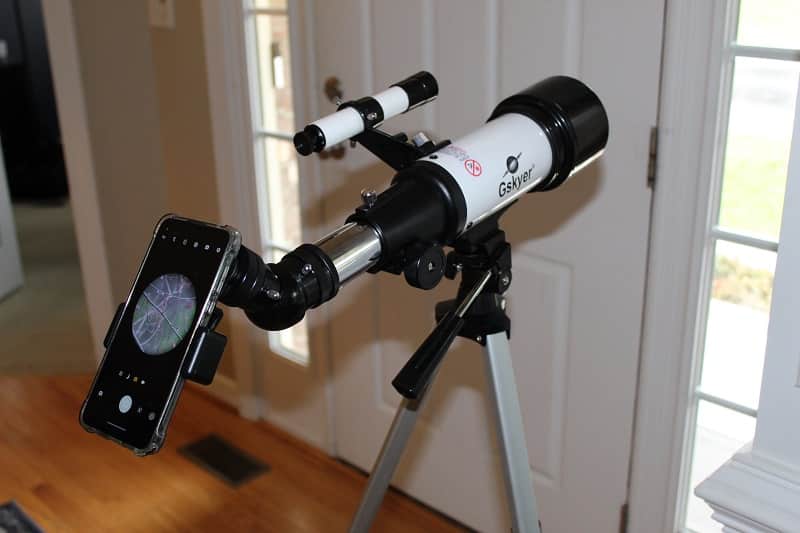
Image Credit: Brian Taylor / TelescopeGuide.org
Second, it’s hard to beat the ease of use, portability, and just overall simplicity of this telescope. It’s ultra-lightweight, and you’ll be stargazing in seconds.
Finally, despite the low price point, the quality is actually not too bad – for example, the optics are glass and fully-coated. And you probably wouldn’t expect all the “extras” you get with a telescope in this price range, like the smartphone mount, wireless remote control, multiple eyepieces, Barlow lens, 5×24 finder scope, aluminum-alloy tripod, and carrying case. Overall, this is a fantastic starter scope for anyone.
(For more on this one, see our full review of the Gskyer 70mm.)
Pros
- Perfect for kids or beginners
- Comes with smartphone mount (and a wireless remote control)
- Sets up in minutes, and drop-dead simple to use
- Lifetime maintenance from Gskyer
Cons
- As with the traveling scopes, it’s not for high-powered viewing
Celestron 70mm Portable Refractor Telescope Travel Scope
Great starter travel telescope on a small budget. You’ll love this ultra-portable telescope that has everything you need for viewing on the go. Celestron’s 70mm travel scope is one of their bestselling telescopes, and for good reason. If you have a little more money to spend we would recommend the 80mm instead as it’s slightly brighter and includes a smartphone mount – but you really can’t go wrong with the 70mm.
Scorecard – Celestron 70mm Travel Scope
| Category | Our Verdict | Why? |
|---|---|---|
| Skill Level | Beginner | For beginners of all ages |
| Quality | 4 out of 5 | Good optics, but let down by the accessories |
| Ease of Use | 4 out of 5 | Generally very easy, but needs a better finder and tripod |
| Power & Clarity | 3 out of 5 | Limited to about 100x in magnification |
| Control | 4 out of 5 | Generally very easy, but the tripod hampered |
| Portability | 5 out of 5 | Super light, ideal for camping and hiking |
| Accessories | 2 out of 5 | The eyepieces aren't terrible, but generally everything needs to be replaced |
| Overall Value | 4 out of 5 | Good for the price, but you'll need to pay more for decent accessories |
Why We Like It
Just like its 80mm sibling, the top reason to buy this 70mm Celestron travel telescope is for portability. Weighing in at 3.3 lbs. (seriously!), the telescope and all its accessories (even the tripod) packs easily into a custom canvas backpack so you can take it anywhere.
Additionally, it comes with a good set of starter accessories, including two eyepieces (20mm and 10mm), an erect image star diagonal, a finder scope, adjustable tripod, and of course the traveling backpack. And, the mount is Alt-Azimuth which is fine for a traveling scope.
It’s not the highest-powered telescope in the world, with magnification of 20x to 40x using the included eyepieces – but that’s plenty for viewing the moon, other solar system objects, planets, and star clusters. Plus, with the star diagonal you can use it as a spotting telescope in the daylight. The optics are fully-coated glass and the telescope is still backed by Celestron’s two-year warranty.
Overall, it’s an incredibly popular telescope because it’s hard to beat the value offered.
Pros
- Designed for “on the go” viewing
- Ultra-portable and ultra-lightweight at just 3.3 lbs.
- All the accessories you need including tripod and travel backpack
Cons
- Not for high-powered viewing
- Does not include the smartphone mount like the 80mm Celestron travel scope
Honorable Mention #1 – If Your Budget is More Flexible
Celestron PowerSeeker 114EQ Manual Equatorial Reflector Telescope
Affordable telescope for beginners – excellent power and control on a budget. The PowerSeeker 114EQ is really a great pick if you’re looking for ease of use combined with higher-powered magnification and light collection. If you’re a true beginner but you’re not satisfied with the lower levels of magnification and/or brightness you’ll typically see in this price range, this could be the perfect telescope for you.
As a classical Newtonian Reflector, it still requires collimation but it’s less daunting (vs. the Bird-Jones design you’ll see in the PowerSeeker 127EQ and the Astromaster 114EQ). Plus, you get the equatorial mount (for smooth tracking) and a good set of starter accessories. Our opinion is that this is really the best blend of options for beginners in this price range.
Scorecard – Celestron PowerSeeker 114EQ
| Category | Our Verdict | Why? |
|---|---|---|
| Skill Level | Beginner | Suitable for beginners |
| Quality | 3 out of 5 | Good component quality |
| Ease of Use | 4 out of 5 | Requires collimation but not as difficult as Bird-Jones design reflectors |
| Power & Clarity | 4 out of 5 | Great magnification and light collection |
| Control | 4 out of 5 | Smooth EQ controls |
| Portability | 3 out of 5 | A little heavy, and not as compact as some of the other reflectors |
| Accessories | 4 out of 5 | Everything needed plus two eyepieces and a 3x Barlow lens |
| Overall Value | 5 out of 5 | Excellent value! |
Why We Like It
The Celestron PowerSeeker 114EQ offers a fantastic level of power and control without sacrificing too much in other areas. With a large aperture of 114mm and focal length of 900mm, it offers magnification ranging from 45x to 225x with its two eyepieces (20mm and 4mm) plus a 3x Barlow lens to triple the power of each eyepiece.
The Manual German Equatorial mount features a slow-motion altitude rod, enabling smooth control as you track objects across the sky. (This is superior to the Alt-Azimuth style mount, but will require a little bit of learning to get the hang of it.)
Weighing in at 18.9 lbs., and on the larger side due to its design, it’s not a traveling scope, but still portable if you’re OK handling its size and weight. In terms of quality, the PowerSeeker line of telescopes are still budget telescopes. While the optics are all-glass, you’ll still find plastic components in the focuser, the finder scope, and the tripod attachment rings. You get what you pay for – but, again, this telescope offers great “bang for the buck” which is why it’s our overall top recommendation on this page.
Pros
- Excellent clarity out of the box
- High-powered telescope with a classical Newtonian reflector and EQ mount
- Still requires collimation but it’s not as difficult as Bird-Jones style
- Everything you need to get started including a tripod, a basic finder scope, two eyepieces, plus a 3x Barlow lens
- Celestron’s technical support team is based out of the U.S., and you get two years unlimited access with purchase
Cons
- Not ultra-portable
- Component quality is good, but this is still a budget telescope
Recommended Accessories
Click here to expand- Celestron sells a nice kit of upgrades specifically for the PowerSeeker line of product:
- Smartphone adapter so you can easily take images through the telescope:
Honorable Mention #2 – If Your Budget is More Flexible
Celestron PowerSeeker 127EQ Manual Equatorial Reflector Telescope
Large aperture for high-powered light collection, but not for true beginners. If you’re looking for a more powerful telescope on a tight budget, you’ll love this reflector telescope which offers a great combination of features at an affordable price.
The PowerSeeker 127EQ from Celestron, with its Manual German Equatorial mount design, has excellent magnification power while also providing flexibility, portability, and user-friendly design. However, you should be aware that it’s not a classical Newtonian Reflector (it’s actually a Bird-Jones style) which makes it more compact, but also more challenging to collimate.
Scorecard – Celestron PowerSeeker 127EQ
| Category | Our Verdict | Why? |
|---|---|---|
| Skill Level | Intermediate | Not for true beginners |
| Quality | 3 out of 5 | Good component quality |
| Ease of Use | 3 out of 5 | Collimation requires skill |
| Power & Clarity | 4 out of 5 | 250x magnification and plenty of light collection |
| Control | 4 out of 5 | Smooth EQ controls |
| Portability | 3 out of 5 | Compact but heavier than others |
| Accessories | 4 out of 5 | Everything needed plus two eyepieces and a 3x Barlow lens |
| Overall Value | 4 out of 5 | Great value |
Why We Like It
First, this telescope is a step up from all the lower-powered telescopes on this page, but also requires more skill. You’ll be able to get crisp images of Saturn’s rings, clear views of the Moon’s craters, beautiful glimpses of the Galilean moons of Jupiter, and many other celestial objects and sights. The durable and sturdy equatorial mount features large, slow-motion control knobs, making it easy to smoothly track objects in the sky.
Second, with magnification of 50x to 250x with the included eyepiece combinations, this telescope offers plenty of power and flexibility for novice telescope users. (It includes two eyepieces, 4mm and 20mm, plus a 3x Barlow lens which can triple the power of both eyepieces.)
The 127EQ is a solid choice for an advanced telescope on a budget. It provides a superb combination of quality, value, flexibility, and performance. If you’re looking for an inexpensive yet powerful option to enjoy the skies for years, this is a fantastic place to start in this price category.
Pros
- Affordable, great value for this price range
- Necessary accessories included (plus tripod, two eyepieces, and a 3x Barlow lens)
- Large aperture and 1000mm focal length for powerful magnification
- No/minimal possibility of aberration
Cons
- Not super lightweight for traveling – While it’s marketed as being portable, it still weighs 21.4 lbs., so it’s a bit heavier than others
- Not for true beginners – It can be tricky to collimate the Bird-Jones style design, but there are some helpful YouTube videos to help you learn the technique (or even better, you can upgrade to a laser collimator)
Recommended Accessories
Click here to expand- Celestron sells a nice kit of upgrades specifically for the PowerSeeker line of product:
Frequently Asked Questions (FAQ) for Best Telescope Under $200
Do Accessories For Telescopes Make Any Difference?
Yes, absolutely. Most telescopes come with basic accessories, which is great when you’re first getting started. But like any other hobby, you’ll find there a variety of accessory upgrades that will enhance your experience. These include various eyepieces to improve quality and flexibility, a Barlow lens which can enhance the eyepieces you have with additional magnification. You may also want adapters for smartphones and cameras, a better finder scope, and many other upgrades.
What Objects Can I Find Using A Telescope?
Depending on your specific telescope, location, and magnification level – you should be able to see a variety of celestial objects, including the Earth’s moon and its craters, the rings of Saturn, the moons of Jupiter, the Orion Nebula, the Andromeda Galaxy, the Pleiades Open Star Cluster, and more. There are plenty of thrilling wonders in our solar system and beyond, and you’ll need a telescope to fully appreciate the beauty of the universe.
How Can I Find Things In The Sky?
Finding and identifying things to view takes time, practice, the right equipment, helpful software, and a growing knowledge of astronomy. Additionally, it helps to have a good finder scope (like the Telrad Finder Sight). If you’re just getting started, one common tactic for beginners is to commence viewing from the Moon as it’s the easiest object in the sky to locate.
Many of the telescopes on this page come with software that will help you find your bearings. Regardless of which telescope you buy, it’s definitely worth your time to download the included software and learn how to use it. If you do, it will save you time and really help you get the most out of your telescope.
What’s the Difference Between the “EQ” and “AZ” Models?
The EQ models have Equatorial mounts, while the AZ models are Alt-Azimuth. Equatorial mounts take some practice and skill, but ultimately will provide finer control and enable you to track objects smoothly as the earth’s rotation causes them to drift across the sky.
Can I Take Photographs Through A Telescope?
Yes, indeed, you can. This is known as “astrophotography” and it requires a smartphone or high-definition camera, plus the right adapter and methodology for your telescope. Check out our guide to the best astrophotography telescopes.
Conclusion – Best Telescope Under $200
If you’re looking for the best telescope under 200 bucks, it ultimately depends on your priorities.
If your #1 priority is power & clarity, you will likely want to pick a reflector design with an aperture of 114mm or higher and a long focal length. However, if you care more about ease of use, you might decide on one of the refractors on this page.
If portability is all-important, you might even go for one of the travel scopes or at least one of the lighter-weight refractors. On the other hand, if you’re looking for fine control and ability to track objects across the sky, you’ll want an equatorial mount (but you’ll also need to put in a bit more effort to learn the best way to use it).
And finally, if you’re looking for more of a blend, there are a few great options here as well. In particular, we think the PowerSeeker 114EQ is one of the better all-around options.
We hope this review list has been helpful in your search for the best telescope under $200. Now it’s your turn to pick your favorite and start enjoying the heavens!
(Also, if you liked this article, please share it using the social media buttons below!)
Feature Image Credit: FG Trade / iStock










